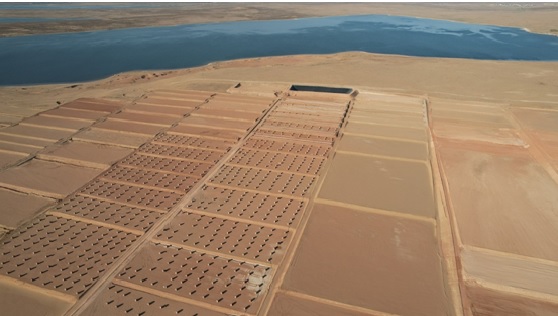By Qin Ruijie, People’s Daily
It’s impossible for saline-alkali soil to turn fertile, but it can generate profits when used properly.
In an industrial park in Yanchi, a county in northwest China’s Ningxia Hui autonomous region that lies on the southern brink of the Mu Us Desert, there are nearly 800 greenhouses built on a vast expanse of saline-alkali soil.
In the greenhouses, no trace of fruits or vegetables can be found, and what’s seen there is spirulina. Besides, whiteleg shrimps are also bred in some of the greenhouses.
The annual precipitation in Yanchi county stands at around 200 millimeters, while the evaporation is as high as 1,500 millimeters. That’s why the county is covered by a number of salt lakes.
To make the infertile saline-alkali soil productive, local authorities have introduced aquaculture and algae processing enterprises, and established 2,500 mu (167 hectares) of breeding bases. Today, the industrial park produces 500 tons of spirulina and 20 tons of phycocyanin on an annual basis.
The story of Yanchi proves that only by thinking out of the box and proactively making changes can industrial structure be optimized, industries well developed, and high-quality development achieved.
Yanchi has transformed the elements that once constrained its development into unique advantages that help it achieve success.
For instance, Yanchi is home to 280,000 mu of saline-alkali land with a pH value of over 9. The underground water there perfectly meets the demand for brine in spirulina breeding. The long sunshine duration in the county ensures that the spirulina receives enough heat for growth, and the low rent of saline-alkali land has reduced the operation costs of the business.
Most of the enterprises in the industrial park were engaged in the production of spirulina tablets and powder. However, they faced severe market competition due to the single product line. To improve the added value of their products, some enterprises have introduced new technologies to abstract phycocyanin, the most nutritious part, from spirulina. The extended industrial chain further expanded the prospects of the local spirulina industry.
Enterprises must adhere to green development and circular economy in order to further expand their businesses. At present, the industrial park is trying to relocate spirulina from the greenhouses to glass tubes, as the tubes, which stretch a total of over 8,000 meters, ensure sufficient sunlight and thus improve the algae’s growth efficiency. Besides, the tubes also help the centralized disposal of waste brine.
The industrial park will also launch a demonstration program that involves photovoltaic power generation, spirulina breeding and aquaculture, as well as sewage disposal.
The success of the industrial park indicates that it is totally possible to turn negative factors into advantages and achieve a win-win of economic growth and environmental protection by efficiently exploiting local resources, advancing technological innovation, and following a path of sustainable development that’s energy-conserving and environmental-friendly.
It is believed that with targeted measures that suit local conditions, China’s high-quality development will embrace brighter prospects.













